Minnesota is a place of versatile activities and the tree frog has been highly active in this region.
I found 6 types of tree frogs in Minnesota and these are Gray tree frog, Cope’s gray tree frog, Boreal chorus frog, Blanchard’s cricket frog, Spring peeper frog and Western chorus frog.
Throughout this article, I will talk about the diet, habitat, lifespan, breeding spots, and much more about these lovely species so that you can get a better understanding these Minnesotans.
So, stay tuned as I explain them one by one in the following part.
1. Gray tree frog
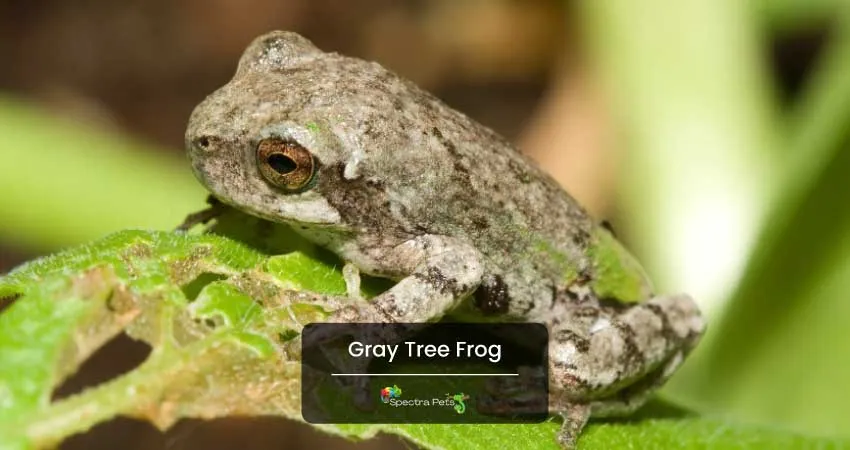
The gray tree frog is one of those amphibians who know the proper tactics to hide from the predator. This warty little life can alter its skin hue to mimic the same color as the surroundings and substrate.
Plus, they are widely distributed over Minnesota, Vermont, Ohio, Texas, Alabama, Tennessee, Indiana, Pennsylvania, etc.
Due to their ability to secrete mild toxins, they can ward off predators. Any time a predator tries to bite or eat them, they generate a toxic that makes them disgusting food and the killer instantly leaves them on spot. Not only that, they give a red signal to their hunter with bright skin color.
They are the perfect definition of tree frogs as they love getting high on trees. And their sticky toe pad gives them high-level support. In addition to that, they’re among the largest members of the Hylidae and get up to 2.25″ big.
Besides, they choose moist woodland forests, swamps, and agricultural land as their home. Also, they like temporary pools, fishless ponds, roadside ditches, edges of lakes, and swamps.
Gray tree frogs eat a significant amount of insects like moths, tree crickets, grasshoppers, beetles, plant lice, snails, and ants. Due to their cannibalistic nature, they don’t miss the chance to hunt smaller size frogs.
These Hylidae frogs can emit an ultra-loud call. The male uses the call to get the female right onto the breeding spot. Adding to that, during the breeding period, the male turns very aggressive and will engage in heavy fights with other males over territory. When the mating is done, the mommy frog lays around 2000 eggs in one season.
Moreover, the breeding season of these cute species remains from April-August. Speaking of lifespan, this tree frog has a 7-9 years average life in their natural habitat. Around 2 years of age, they reach sexual maturity.
When it comes to skin color, it can vary from green to gray and brown. This magnificent critter changes the skin color into a darker shade on days when the temperature is a bit high. During the night, their skin tone gets lighter when the temperature remains a bit low.
2. Cope’s gray tree frog
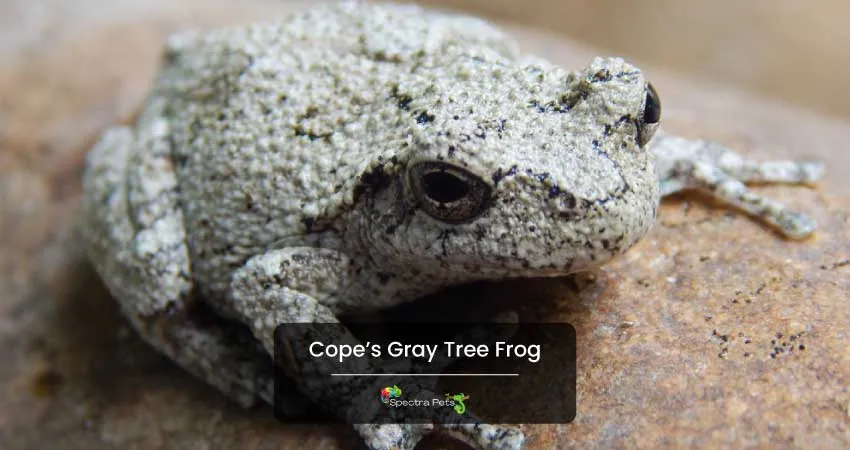
Due to their high population across multiple states, you can guess that these frogs are indeed tough creatures. And you can see that the average lifespan of this species is 2.5 years while the highest was recorded at 7 years old.
Along with Minnesota, they are found in Oklahoma, Florida, Kansas, Indiana, Ohio, Wisconsin, etc. Typically they love to reside in wooded zones nearby ponds or lakes. Also, they want to stay under thick vegetation which gives them a natural shelter from predators.
Plus, they choose flooded fields, roadside ditches, marshes, ponds, and puddles as breeding grounds. As they reach sexual maturity at 2 years, they start mating on the closest April month when the humidity remains at peak level. The breeding period lasts until July.
Moreover, the female joins the male frog into the temporary pool after the male starts calling frequently. Following a single mating, the mother frog can lay up to 200 eggs on the surface water.
The native people of Minnesota have a high chance to see this little buddy in their backyard close to the garden lights. Speaking of color, it can have various colors like green, gray, or brown. The skin color of these lovely amphibians changes with the altar of temperature and darkness.
It’s almost a rare thing for them to travel around day time. Their nocturnal pattern let them hunt food under darkness. They take rest by hiding under trees and shrubs.
Besides, their body size varies from 1.25 – 2’’ in length. And the female Copes’ gray tree frogs are bigger than their male partner. Whenever the winter slowly enters, this intelligent critter gets into a hibernation mood. So blood thickening winter is no problem for them.
The Diet of these amphibians is packed with varieties of insects like mosquitoes, spiders, ants, snails, crickets, beetles, etc. On the other hand, predators like raccoons, crayfish, salamanders, snakes, and birds of prey eat cope gray tree frogs.
3. Boreal chorus frog
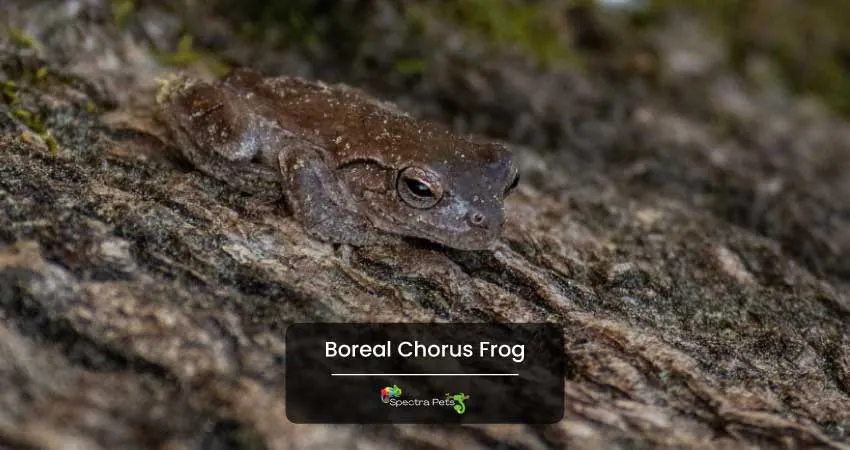
Available in various colors, this tree frog is a miniature size amphibian that has a significant population in states like Minnesota, Alabama, Arizona, New Mexico, Wisconsin, Indiana, Lowa, Kansas, Ohio, etc. Their stable growth is the reason for becoming a least concerned amphibian.
Plus, their dorsal color can vary from gray, tan, olive, brown, red, and green. On top of that, they have brown, red, black, and gray stripes on their back. Similar to other Hylidae siblings, their size is small & can vary from 0 .75 to 1.5 inches. And, the female is heavier and bigger than the male.
In addition to that, these amazing species can move close to 250 meters. On rare occasions, they move around 700 meters from their birthplace.
Regarding the habitat, these wonderful species choose grassland, shrubland, and nearby woodland ponds. Their hibernation ability gives them solid support to pass the winter without any physical problems. For the winter season, this clever frog goes underground, beneath dense vegetation, below tree logs, and under the rocks.
Moreover, they begin their breeding activity in March and continue till June. During this time, the male becomes highly active. They start calling the female to the breeding zone. The calling duration is mostly night to dawn.
As soon as the female comes to the breeding area, they start the mating process. Generally, they prefer flooded fields, small lakes, marshes, and temporary ponds as their breeding spot.
Whenever they feel the presence of the predator, using their climbing skill, they will evade the predator. If the predator is a terrestrial one then it will try to jump on the water & swim away from the hunter.
In terms of appearance, the male & female boreal chorus frogs have strong differences. First of all, the male is smaller than the female. Then, the male has yellow/green throat color, whereas the female has a cream color throat.
While they eat insects like spiders, mites, ants, earthworms, and flies; they serve as food for wading birds, snakes, crayfish, raccoons, etc. Speaking of lifespan these species live around 2 years, and few can make 3+ years in the wild.
4. Blanchard’s cricket frog
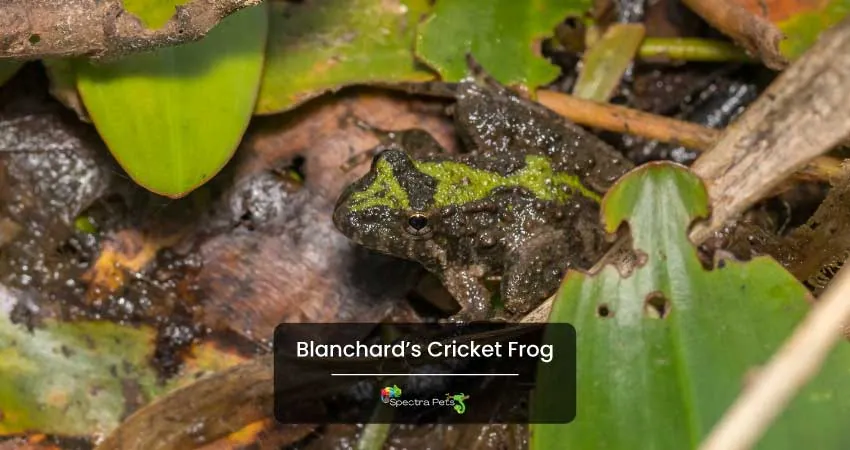
The distribution of this tree frog is in many areas of the USA which includes Minnesota, Wisconsin, Lowa, Texas, Kansas, etc.
Plus, this warty skin amphibian can grow up to 1.5″ in size. And their skin color is either green, tan, brown, or greenish tan. Along with that, on their back, you can see red, yellow, orange, and black markings.
Like many other states, they are listed as an endangered species. Though in winter time, they take shelter in crayfish holes or cracks of ponds only 5% of the total population makes their journey to the summer season. Adults that survive the winter usually live for around 1-2 years in the wild. Most frogs die around 4 months.
For natural habitat, these little buddies choose ponds, slow-moving streams, marshes, mud flats, shallow wetlands, etc. Though it’s uncommon on rare occasions they also get into large lakes and polluted sites.
They like to be under rocks and tree logs close to the water when it’s daytime. As soon as the night begins, they start roaming around for food. However, some people observed them outside during sunny weather but that’s a rare case.
In terms of adaptation, their skin color and webbed toe pad play a big role to run away from predators. Using the webbed toe, they can swim like a boss. And the skin color of this frog works as a natural camouflage & they get lost in the eyes of their predator.
Moreover, their predator list includes snakes, birds of prey, foxes, raccoons, turtles, and large fish. Speaking of their diet, this tree frog enjoys small invertebrates and a few insects like ants, beetles, moths, and crickets.
Furthermore, the breeding season is quite long and remains from May-August. One unique attribute of this species is they become highly triggered by rain for mating. Similar to many amphibians they reach sexual maturity in 1 year.
Speaking of their call, the male emits a metallic sound to attract the female. From Spring – Summer, they can call at both day & night. During the breeding period, the male’s throat gets darker and the female’s throat is always light in color.
5. Spring peeper frog
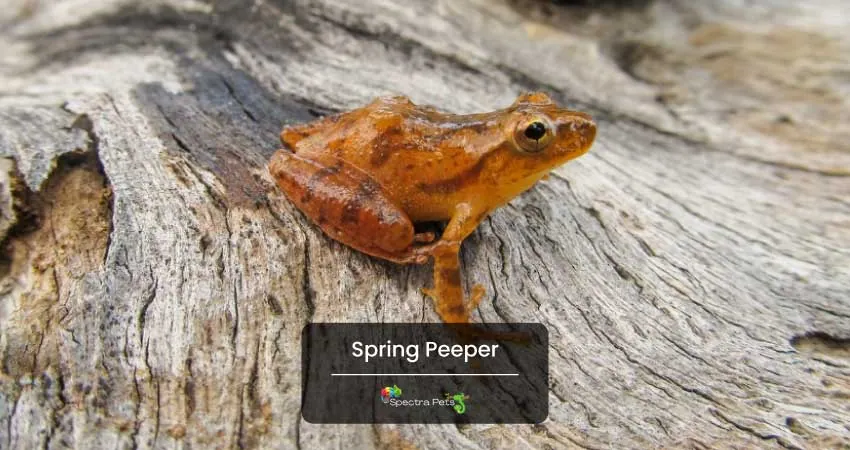
The spring peeper is a frog that lives in the southeastern United States. It has light skin color brown, greenish, reddish, tan, etc. And it can grow up to 1.5 inches long. The spring peeper eats insects, spiders, beetles, ants, flies, and worms.
Besides, the spring peeper has a lifespan of two years or more depending on the environment it lives in; if it lives in an urban area where there are no predators around then it can live as long as four years!
Moreover, they have a high attraction for moisture-loaded areas so they choose their habitat as grassy lowland and woodland areas close to water bodies like ponds or lakes. Their population is significant amount which makes it the least concerning for amphibians.
In search of food and finding breeding spots, they can travel. And their average travel range is around 20-130 feet. These frogs do an awesome job by consuming a big amount of insects from the local ecosystem.
They have a specific time for hunting. The adult ones look for insects during the late afternoon while the young froglets keep their search from morning to afternoon.
Despite the wide list of predators, this critter evades them with its crazy jumping skill. They can cross around 1.5 feet with a single jump. In the wild habitat predators like birds of prey, salamanders, larger spiders, snakes, and raptors usually hunt these little fellas.
The breeding season of this colorful frog ranges from March-June. During this time, the male goes hyper and heavily calls out the female frog. The calling sound is repeated 20 times in a single minute. Female approaches to the male make the loudest among all males.
As soon as the female arrives in the breeding spot like dishless ponds, roadside ditches, or seasonal pools, the male starts the mating process. A successful mating means the lady frog will lay at least around 1200 eggs that will become froglets in the next 3 months.
Unlike many other amphibians, the Spring peeper frog is blessed with top-notch hibernation ability that gives them full support during winter. They usually spend the full winter staying under tree barks, below tree logs, soft mud, etc.
6. Western chorus frog
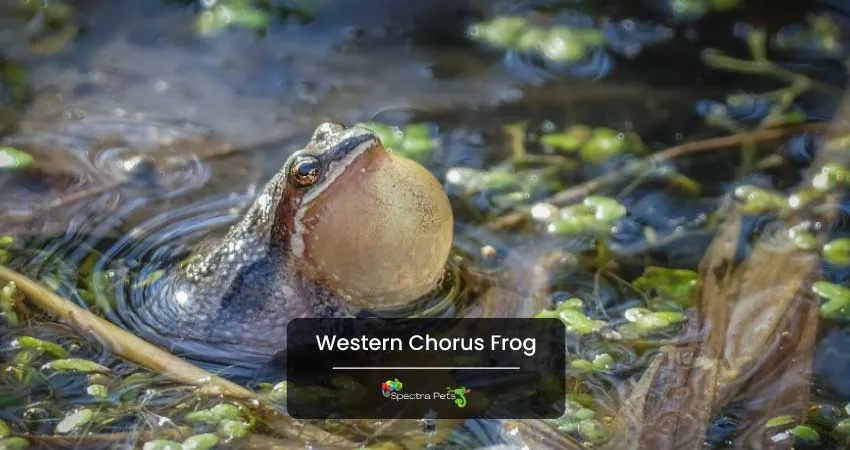
Another tree frog has a strong presence in Minnesota, Ohio, Indiana, Florida, Texas, Lowa, and Pennsylvania. This species can live high up to 12000 ft above sea level. Currently, they are known as Midland chorus frogs.
These squishy frogs select meadows, bog, grassy pools, and close woodland ponds, etc as their natural habitat. Also, they love being in highly moisture & temperate zone so don’t be surprised if they start to hang out in agricultural land.
For breeding, the Western chorus frog prefers flooded fields, swamps, marshes, and flooded fields. The male gets sexual maturity around 1 year and the female becomes sexually mature within 1-2 years.
A small number of these amphibians can live more than 3 years. And the average lifespan is only 1 year.
Moreover, their skin type is smooth & the three dark stripes are on their back. You can see them in versatile colors like olive, gray, brown, reddish, greenish-gray, etc. Their skin shade gives them immense advantages in getting blend with the surrounding habitat.
If you look at their food list, it’s loaded with insects and animals like springtails, beetles, snails, ants, and caterpillars. Usually, their habitat is full of these insects and an adult frog can grow up to 1.5″ in length.
In addition to that, their position in the food chain makes them desirable food for salamanders, minks, crayfish, snakes, raccoons, and birds of prey.
Due to their top-notch antifreeze ability, they smoothly spend the winter. For safety, during winter they take shelter under the ground or tree logs.
With the appearance of the breeding season, the male starts making a chorus to grab the female’s attention. They will make the call day & night restlessly.
Adding to that, the mating season stays from March-June and after the mating, the mommy frog will lay 1400 eggs. And most of the eggs become froglets within 3 months and join the party in the ecosystem of Minnesota.
Despite belonging to the Tree frog family, they don’t climb on trees but rather stay on the ground.
Final words
Here you saw a lot of information about different attributes of Minnesota tree frogs.
Whether you are a researcher or a random frog enthusiast, hopefully you got the knowledge you were looking for.
Now it’s time to brag that you have some real stuff about the tree frogs in Minnesota.
Tree Frogs Found in the Nearby States of Minnesota:
